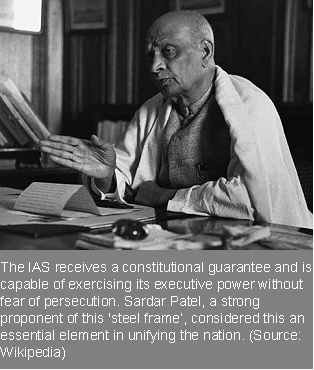Civil Services in India
By Bashyam Ramasami ('95 Engineering Technology)
Growing up in a District headquarters, I have to mention the awe and respect I held towards the District collector, a member of the so-called saahibdom created by the British rulers of Imperial India. The collector’s name would come up in many a different context. Someone invited to hoist the national flag at the district sports stadium on National holidays. The chief guest of honor at the school’s annual sports day. He was just about everything – the celebrity, the administrator and the super cop – all rolled into one.
 To put things into perspective, the District collector is really like the middle management in a regular corporation. He belongs to the cadre of officers referred to as the Indian Administrative Service or ‘IAS’ for short. The IAS and the other administrative wings of the Indian Government is one of the features left behind by the colonial administration. Previously referred to as the Imperial Civil Service, and later as the Civil Service of India and finally from 1911 as the Indian Civil Service, this group of officers was the tiny administrative elite of the British. These officers were appointed under section XXXII of the Government of India Act of 1858 in the post ‘Sepoy Mutiny’ era when the governance of India transferred from the East India Company completely to the Crown in England. Initially these positions were restricted only to the ‘British Sahibs’ and the extensive selection process took place in London. The exam was completely in English and it required an extensive knowledge of both British Laws and Indian Geography and culture. It was not until much later that the selection exams were also held in Allahabad and it was not until 1922 when Indians were allowed to be a part of the civil service. To put things into perspective, the District collector is really like the middle management in a regular corporation. He belongs to the cadre of officers referred to as the Indian Administrative Service or ‘IAS’ for short. The IAS and the other administrative wings of the Indian Government is one of the features left behind by the colonial administration. Previously referred to as the Imperial Civil Service, and later as the Civil Service of India and finally from 1911 as the Indian Civil Service, this group of officers was the tiny administrative elite of the British. These officers were appointed under section XXXII of the Government of India Act of 1858 in the post ‘Sepoy Mutiny’ era when the governance of India transferred from the East India Company completely to the Crown in England. Initially these positions were restricted only to the ‘British Sahibs’ and the extensive selection process took place in London. The exam was completely in English and it required an extensive knowledge of both British Laws and Indian Geography and culture. It was not until much later that the selection exams were also held in Allahabad and it was not until 1922 when Indians were allowed to be a part of the civil service.
The IAS replaced the ICS and the pre-independence structure of all-India services, provincial or state services and central or Union government services was retained. Despite the initial resentment by Pandit Nehru and Sardar Patel towards the arm of governance under the British Raj, at the time of drafting the constitution, the need for this arm was extensively felt. Sardar Patel argued for this wing of the bureaucracy referring to it as the ‘Steel Frame’ and proposed that this body should be vested with the authority to speak out freely, without any fear of persecution or financial insecurity. Article 312 of the Indian Constitution led to the creation of the All India Services Act of 1951 and the officers who make it to the All India Services, on appointment by the government of India, will be deputed to different States and are at the disposal of the respective State Governments. These services include the Indian Administrative Service, the Indian Police Service (IPS), the Indian Forest Service and the Central Service, which among others includes the most coveted Indian Foreign Service (IFS). Running the administration of a vast and diverse country like India requires efficient management of its natural, economic and human resources and that, precisely, is the responsibility of the civil services. Selection to the civil services in India has still not lost its imperial charm. Tens of thousands of young graduates even today are willing to rough it out and chalk their way into the Indian Administration.
Many distinguished bureaucrats who have done well in the services include foreign secretary of India, Ms Choklia Iyer, an Indian Foreign Services (IFS) officer and the first woman to occupy the post in the year 2000 as well as Ms Kiran Bedi, IPS, the super cop who mooted the concept of prison reform in Delhi’s Tihar Jail. Ms Vijayalakshmi Bidari was the topper of the Civil services exams in the year 2001. Dr P C Alexander and Mr. T N Seshan are other well-known IAS officers who rose to positions of prominence.
Civil servants not only rely on their intellectual ability but also on their people skills to be able to deal with situations. A lot of media attention adds enormous pressure to the day to day work of a civil servant.
With rampant corruption in India, civil servants have to bring with them a lot of personal integrity to get through their job.
I would speculate that my sense of awe and my respect for the District Collectors are more than justified. |

